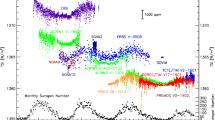Abstract
In order to uncover a possible influence on the Earth’s climate, we need a much longer time series, i.e., the total solar irradiance (TSI) which is also an interesting issue in its own right in solar physics. By comparing different solar indices associated with TSI during the period 1979 to 2009, several empirical models in the TSI are presented. We verify that the reconstruction model based on the three variables: sunspot number, sunspot area, and solar 10.7 cm radio flux, is the best one. As demonstrated by model calculations, the history of TSI was reconstructed back to 1947 based on 3-indices and to 1874 based on 2-indices, respectively. The reason that the reduced irradiance on the trough during 2006 to 2009 lasts long may be due to the about 85-year cycle of solar activity, which modulates the intensity of the 11-year cycle (Schwabe cycles), possesses a considerable potential to produce an effective reducing, and holds on a steadily lower level of irradiance.
Similar content being viewed by others
References
Reid G C. Influence of solar variability on global sea surface temperatures. Nature, 1987, 329: 142–143
Kelly P M. Solar influence on North Atlantic mean sea level pressure. Nature, 1977, 269: 320–322
Tinsley B A. Solar wind mechanism suggested for weather and climate change. EOS, Trans Am Geophys Union, 1994, 75: 369–374
Lean J, Beer J, Bradley R. Reconstruction of solar irradiance since 1610: Imp1ications for climate change. Geophys Res Lett, 1995, 22(23): 3195–3198
Solanki S K, Fligge M. A reconstruction of tota1 solar irradiance since 1700. Geophys Res Lett, 1999, 26(16): 2465–2468
Preminger D G, Walton S R. A new model of total solar irradiance based on sunspot areas. Geophys Res Lett, 2005, 32: L14109
Fröhlich C. Evidence of a long-term trend in total solar irradiance. Astron Astrophys, 2009, 501(3): L27–L30
Krivova N A, Balmaceda L, Solanki S K. Reconstruction of solar total irradiance since 1700 from the surface magnetic flux. Astron Astrophys, 2007, 467(1): 335–346
Edouard B, Grant R, Franc O Y, et al. Solar irradiance during the last 1200 years based on cosmogenic nuclides. Tellus, 2000, 52B: 985–992
Haigh J D. The effects of solar variability on the Earth’s climate. Philos Trans R Soc London Ser A, 2003, 361(1802): 95–111
Lin Y Z. Introduction to Solar Physics. Beijing: Science Press, 2000. 82–83
Gui M L, Jia L W. Wavelet analysis of several important periodic properties in the relative sunspot numbers. Chin J Astron Astrophys, 2003, 3(5): 391–394
Gui M L. Wavelet analysis of the Schwabe cycle properties in solar activity. Chin J Astron Astrophys, 2004, 4(6): 578–582
Li K J, Qiu J, Su T W, et al. Sunspot unit area: A new parameter to describe long-term solar variability. Astrophys J, 2005, 621: L81–L84
Li K J, Feng W, Liang H F, et al. A brief review on the presentation of cycle 24, the first integrated solar cycle in the new millennium. Ann Geophys, 2011, 29: 341–348
White O R, Rottman G J. Solar variability observations—discussion session 1a. Space Sci Rev, 94(1–2): 93–97
de Toma G, White O R, Chapman G A, et al. Differences in the Sun’s radiative output in cycles 22 and 23. Astrophys J Lett, 2001, 549(1): L131–L134
de Toma G, White O R, Chapman G A, et al. Solar cycle 23: An anomalous cycle? Astrophys J, 2004, 609(2): 1140–1152
Gleissberg W. The probable behaviour of sunspot cycle 21. Solar Phys, 1971, 21: 240–245
Zhao J, Han Y B, Li Z A. Effect of solar activity on annual precipitation in Beijing area. Chin J Astron Astrophys, 2004, 4(2): 189–197
Zhao J, Han Y B. Determination of precipitation cycle in Beijing area and comparison with solar activity cycle. Earth Moon and Planets, 2005, 97(1–2): 69–78
Author information
Authors and Affiliations
Corresponding author
Rights and permissions
About this article
Cite this article
Zhao, J., Han, Y. Sun’s total irradiance reconstruction based on multiple solar indices. Sci. China Phys. Mech. Astron. 55, 179–186 (2012). https://doi.org/10.1007/s11433-011-4496-5
Received:
Accepted:
Published:
Issue Date:
DOI: https://doi.org/10.1007/s11433-011-4496-5




